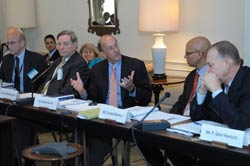US-India research collaboration addresses HIV, other sexually transmitted diseases
November - December, 2009 | Volume 8, Issue 6
By David Taylor
U.S. and Indian scientists gathered recently at NIH to review progress on international research collaborations in the area of HIV/AIDS and other sexually transmitted diseases.
Asia, home to 60 percent of the world's population, is second only to sub-Saharan Africa in terms of the number of people living with HIV, according to the latest U.N. statistics. India accounts for roughly half of Asia's HIV prevalence.
This session of the US-India Joint Working Group on Prevention of Sexually Transmitted Diseases and HIV/AIDS was the first opportunity for researchers to report on progress made under grants awarded since the program began in 2006. The initiative is part of the implementation of the U.S.-Indo Joint Statement on Collaboration on Prevention of Sexually Transmitted Diseases and HIV/AIDS signed by the HHS Secretary and the Indian Minister of Health.

Photo by Michael Spencer
The meeting of the US-India Joint Working
Group on Prevention of Sexually Transmitted
Diseases and HIV/AIDS was the first opportunity
for researchers to report on progress made since
the joint U.S.-Indian effort began in 2006.
The working group was established to develop research collaborations and facilitate the expedited review and clearances of funded bilateral projects. This meeting included working group members, U.S. and Indian representatives of the panel of eminent scientists appointed to review the research proposals, NIH program staff, and scientists whose projects received awards.
"This has been a successful two years with a lot of work on both sides," observed Dr. Jack Whitescarver, director of the NIH Office of AIDS Research (OAR) and the JWG's co-chair, who congratulated the researchers and program personnel. The OAR coordinates AIDS research conducted by every NIH Institute and Center, and established this program to promote collaborations between U.S. and Indian scientists on HIV/AIDS research.
Nine NIH Institutes and Centers are participating in the effort, which has three components: to make awards to extramural researchers, to support intramural labs at NIH to expand their collaborations with Indian counterparts, and to support workshops and meetings that encourage collaboration and information sharing.

Photo by Michael Spencer
Fogarty Director Dr. Glass told participants of
the US-India Joint Working Group on Prevention
of Sexually Transmitted Diseases and HIV/AIDS
that the new U.S. administration is committed
enhancing research partnerships with India.
This collaborative program awarded 16 extramural grant supplements in 2007, six grants for exploratory research in 2008, and supported a total of seven intramural projects in 2007 and 2008, ranging across the behavioral and biological sciences. In just two years the funded researchers have already produced findings on risk behaviors and further opportunities for HIV prevention and treatment.
Dr. V.M. Katoch, Secretary of India's Health Research Department, and the meeting's co-chair, called the program "very productive and very vibrant" and "a unique opportunity from the Indian side."
"This is an exciting meeting," observed Fogarty Director Roger I. Glass, "and comes at a wonderful and propitious time." Global health ranks among the top priorities for NIH Director Francis Collins, Glass noted, and the new U.S. administration has committed itself to India, Glass told the 50 participants and observers.
Besides beginning to yield new research directions, the program has strengthened a corps of researchers working on HIV/AIDS through a number of workshops and meetings, including, for example, a session on prevention, care and treatment of HIV-related co-morbidities. Additional training was provided through a grantsmanship workshop for new investigators held in New Delhi.
Meeting participants discussed other ways that the program could foster a new generation of HIV/AIDS research teams. Officials from both governments agreed that short-term training exchanges can help expand the pool of HIV/AIDS biomedical and behavioral researchers. OAR has piloted the Intramural-to-India (I-to-I) Program to draw on NIH's broad internal expertise in HIV/AIDS research and widen the network of NIH scientists working with Indian researchers.
"The I-to-I program has demonstrated how much interest there is in this collaborative program," said Dr. M.K. Bhan, Secretary of India's Biotechnology Department.
Both the U.S. and Indian government members of the working group agreed to continue the research partnership and are discussing possible initiatives for the next phase of the collaboration.
The Indian delegation's visit also included meetings with NIH leadership including Dr. Francis Collins and several Institute Directors, meetings on maternal and child health and vaccine research, and an interactive session with NIH Visiting Fellows.
More Information
To view Adobe PDF files,
download current, free accessible plug-ins from Adobe's website.